Birding the Sky Island Mountains in Southeast Arizona
From the Chiricahuas to Patagonia
Photos by Josh Jackson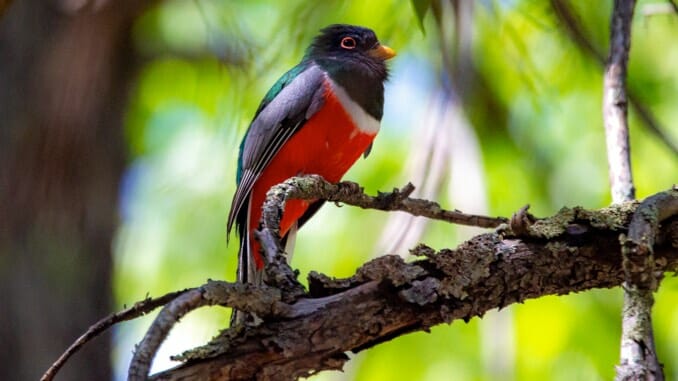
The destinations in the U.S. that get birders excited aren’t necessarily the places that other vacationers are flocking: The border city of McAllen near the southern tip of Texas sits on a major flyway of migrating birds. The marshes northeast of Toledo, Ohio, are the self-proclaimed “Warbler Capital of the World.” And anyone who’s seen the Jack Black movie The Biggest Year knows the most determined American birders head to the remote Aleutian Island of Attu each year in search of rarities from Asia wandering to the tip of Alaska. So you’ll be forgiven if you didn’t know what a birding oasis can be found in the so-called Sky Islands rising out of the desert in Southeast Arizona.
The Chiricahua, Huachuca and Patagonia Mountain ranges are among those unique biomes with incredibly diverse flora and fauna unlike anywhere else in the States. As you climb elevation, the desert scrub gives way to pinyon-juniper grasslands, pine-oak woodlands, mixed conifer and aspen forests—each providing the right environment for a new set of species. The entire population of Elegant Trogon, one of the most fantastical avian creatures in America, breeds solely in the mountains of Arizona each year before migrating deep into Central America. Almost no other place in the U.S. gets as many tropical rarities showing up, bringing plenty of birders chasing after.
I only started paying attention to birds a couple of years ago, and most of my birding has been in and around Atlanta. So when a friend invited me on a trip to the region to celebrate his 50th birthday with three solid days of birding, I jumped at the chance to go exploring.

Welcome to Tucson
To begin our birding in the Sky Islands of Southeastern Arizona, we flew into Tuscon and immediately took an Uber to a greenspace near the airport while we waited on the third member of our party to arrive. One of the birds I most wanted to see was a Greater Roadrunner, that meep-meep bird always one step ahead of Wiley Coyote. It would remain one step ahead of us on the trip, as well. Our closest encounter came in that first Uber ride when our driver spotted one and we, talking away in the backseat, did not.
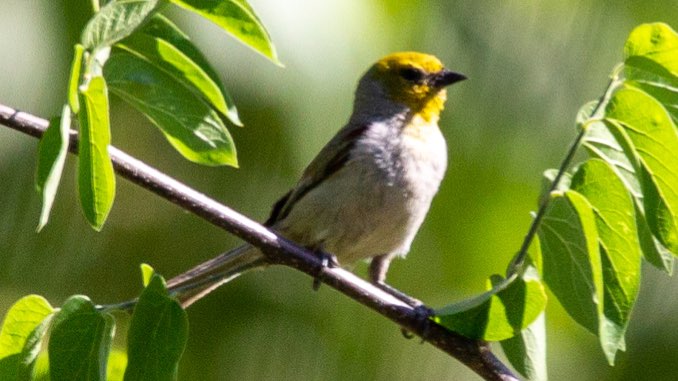
But we did see plenty of other birds in the city, just after arriving and just before our flight. Birding even as we dragged our luggage behind, we identified 23 species at Sam Lena Park, including seven “lifers” for me, or birds I’d never encountered before. My favorite was the Verdin, a little grey little songbird with a bright yellow head and red shoulders whose closest relatives live continents away.
Wilcox: An Oasis in the Desert
I’ve gotten used to the fact that the best birding can be in the strangest places, like a sod farm or a municipal dump site. East of Tuscon on I-10, it’s a man-made lake that was the beginning of a now-abandoned residential neighborhood near the Twin Lakes Gold Course. Lake Cochise Wetland was taken over by the city of Wilcox as part of their wastewater management system—and is now home to hundreds of shorebirds I never expected to see on my desert journey.
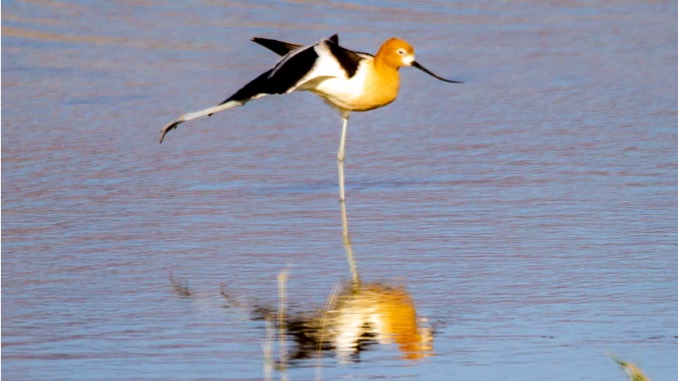
Mexican Ducks, Blue- and Green-Winged Teal, Northern Shovelers, and Wilson’s Phalarope floated on the water. I’d never seen a phalarope before despite coming across them in bird guides the last two years, and I hadn’t realized what small and delicate looking creatures they were—or how hilarious it would be to watch them frantically spin in circles, scaring up their meals. Closer to the water’s edge were White-faced Ibises, American Avocet, Black-necked Stilt, Long-billed Dowitchers and a variety of sandpipers. We saw 36 more species and we hadn’t yet spent a night in Arizona. We’d add Lesser Nighthawk to our list—my 18th lifer of the day—at a gas stop just over the border into New Mexico before getting to our cottage back across the state line.

Portal is for the Birds
It was dark when we arrived to the Four Bar Cottages near the town of Portal (population 757). We met our hostess and told her we were there for the birds, and she said, “Everybody is here for the birds”—why else would we be in Portal? Our bodies were still three hours ahead (Arizona doesn’t observe Daylight’s Savings Time), so we woke up to the dawn chorus at 5am—birds singing out the back door and visiting the feeders in the front yard. I had four lifers before breakfast: a female Lazuli Bunting, giving me hope of seeing its brilliantly colored mate, a bright-yellow-and-black Bullock’s Oriole, Ash-throated Flycatcther and Ladder-backed Woodpecker, all Western species I don’t see back home.
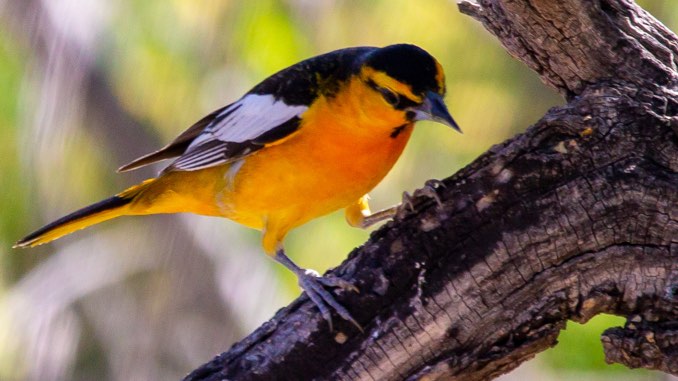
Our first stop was another private home, listed as the “Bob Rodrigues yard (Dave Jasper’s old yard)” on eBird, the mobile app run by the Cornell Lab of Ornithology that keeps track of all your bird sightings. Bob was out of town, but a friend was there diligently refilling the feeders several times a day for the many visitors stopping by (both avian and the humans watching them). I was quickly able to see several of the birds I’d hoped to find, like the Black-headed Grosbeak, the Canyon Wren and the Pyrrhuloxia, a close relative to our Northern Cardinals back home. As a friend pointed out, these should have become the new mascot for NFL’s Arizona Cardinals when they moved from St. Louis to Phoenix.

We met our guide Ken Blankenship in Portal and walked a trail leading straight out of downtown to see the resident Band-tailed Pigeons, adding several new birds along the way, including the only Zone-tailed Hawk we’d see on the trip, despite double-checking every Turkey Vulture flying overhead. We also saw one of the cooler resident hummingbirds, the aptly named Blue-throated Mountain Gem, which hovered right in front of us before zooming off to visit some flowers. Less than a mile away, Ken took us to see one of the few known local nesting sites of the Thick-billed Kingbird, whose range is mostly in Mexico. Then we headed up the mountain.
The Chiricahua Mountains
Chiricahua Peak sits at 9,759 feet above sea level and a striking 6,000 feet above the surrounding desert. The range is divided into nine different life zones, depending mostly on elevation and water flow, and is marked by rust-and-ash-colored hoodoos, or stone columns and spires rising up from the ridges. This was the home of Chiricahua Apaches, and Apache leaders like Cochise and Geronimo lived here in the 1800s before their tribes were forcibly removed by federal troops. The beauty of the land is striking everywhere you look.
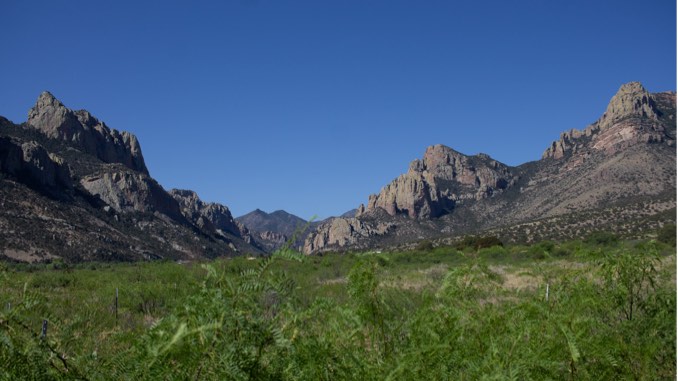
We headed to the south fork of Cave Creek Canyon, passing several groups of birders along the way. In just over an hour we’d find 27 different species of bird, including my #1 target for the trip, the Elegant Trogon. The males are ostentatious with their green, blue, red, white and black feathers, their bright pink eye ring, and their loud, croaky calls. You’d be hard-pressed to find a more tropical-looking bird in the States, and indeed, they spend their winters throughout Central America after breeding in these mountains. It didn’t take us long to find a female on a branch next to its nest cavity and then for the male to take her place.
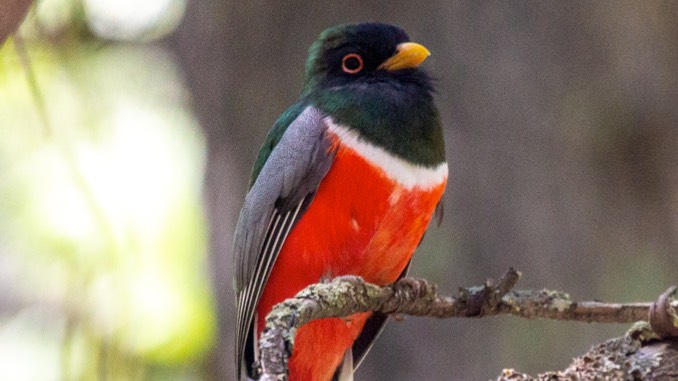
If that weren’t enough, we also saw three new warblers—Painted Redstart with its blood-red belly and midnight-black head, a shy Black-throated Gray Warbler and a Grace’s Warbler with its highlighter-yellow throat—along with Hepatic Tanager, Bridled Titmouse and Mexican Jay.
From there we visited East Turkey Creek, where we saw an enormous Wild Turkey. The mountains get their name from the Opata words for Turkey Mountain (“Chiwi Kawi”), but turkeys were completely wiped out from hunting. According to locals, after a failed effort to reintroduce the native subspecies, the larger Gould’s Turkeys, which thrive in the mountainous regions of Mexico, took hold. Here we saw another 27 species, including our first Mexican Chickadee, Yellow-eyed Junco and Buff-breasted Flycatcher.

Our final stop of before dinner was Pinery Canyon, where we found a Spotted Owl sitting on its nest. The highlight for me, though, were our only sightings of an adorable Red-faced Warbler and a Hermit Warbler. And we weren’t the only ones enjoying the birds. When we finally stopped for dinner at Portal’s lone restaurant, the Portal Peak Lodge, Store & Café, all of the other seven tables on the patio were occupied by people with binoculars (and often those tell-tale floppy hats). This place is for the birds and the birders who love them. Walking into the store, you’re greeted by a notebook where you can add any rare birds you’ve observed that day. The scenery is spectacular, but everyone is here for the flying fauna.
After dark, it was time to listen in on the only nightlife in Portal: Elf Owls and Screech Owls (both Western and Whiskered) and Common Poorwills and Mexican Whip-Poor-Wills. It didn’t take us long to identify all the calls coming from around the canyon, bringing the new lifer total up 40 for the day.
Just another day in Paradise (population 15,186)
The feeders at the Four Bar Cottages were busy again the next morning, and we learned how to tell the difference between the Western Kingbirds I’d seen before and the Cassin’s Kingbird that was a new lifer for me. It was a solid start to an incredible day. On the way to a small man-made wetland we saw our first Prairie Falcon, and on the way back found the Bendaire’s Thrasher we were searching for. Then it was back to Bob’s yard to find one of the few Green-tailed Towhees that hadn’t migrated north just yet.

And then we drove to Paradise. Once a boom-and-bust mining town, now the village boasts B-and-Bs geared for birders. We visited one of the oldest, the George Walker House, where the kind host let us break out our bagged lunch and crack open our beers while we enjoyed the shade, watching Scott’s Orioles, Western Tanagers and Black-headed Grosbeaks visit the feeders and baths. We were surprised by a Lewis’s Woodpecker, common elsewhere out west, but rare around these parts and another new bird for me.

Without a guide, we wandered back up into the Chiricahuas, looking for Mexican Chickadee and Olive Warbler. We found both of them at Rustler Park with Olive Warbler coming unusually low in the pine trees to give us good looks. But not as good as the curious Steller’s Jay who landed right above our heads. We also saw our first Violet-green Swallows soaring high above. It was just turning out to be one of those days where everything was gong our way.
Chiricahua National Monument
Thankfully, rumor of recently fledged Long-eared Owlets took us to the west side of the range and to Chiricahua National Monument. Here visitors could be forgiven for forgetting about birds for a moment and appreciating the splendor of these mountains. Where hoodoos poked their way up here and there on the east side of the ridge, now they were everywhere—impossible rock formations looking like they’d been stacked by a gargantuan toddler, ready to come tumbling down at a sneeze.
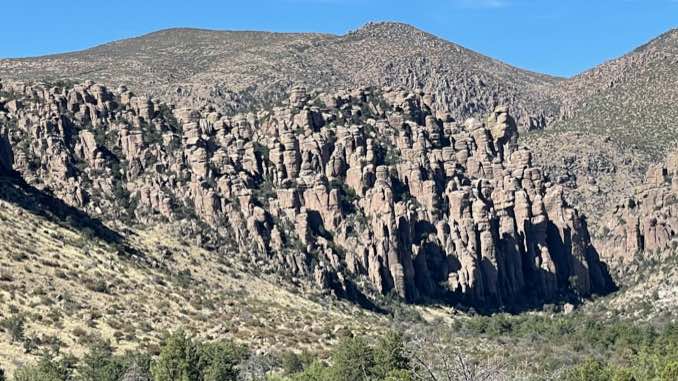
We did find a mother owl with her two offspring, peering down at us with quiet boredom. And seeing any owl in the wild—especially one you’ve never seen before and one watching over youngsters—is memorable. But this was one instance where we may remember the scenery even more.
We had one more rare bird to chase, the rarest of the day. The Tufted Flycatcher’s range is typically Mexico down to Colombia, but one had been spotted at Rucker Canyon, just south of Chiricahua National Monument on the map, but the map didn’t quite capture just how bumpy a dirt road we’d need to take to get there and we spent an hour wondering this would be worth going to for a single bird, even if that bird was classified as a Code-4 rarity by the American Birding Association. Plus, we thought it would test our birding skills just to find it.
In reality, we found a rock painted “TuFl” with an arrow pointing at a tree and within 30 seconds of stopping the car, there was the Tufted Flycatcher fluttering down from its branches. The light was fading, and it flew off before I could get a good photo, but we re-spotted it in the distance down by the water, a tiny, adorable crested bird the color of an apricot. When a car rolled by a few minutes later, the driver asked excitedly, “Did you see it?” “Yes! So cool,” I answered. “The turkey?” It was then we realized we’d ventured far beyond the typical bird-tourism destinations, and not everyone gets excited by a small, pale orange songbird.
The Huachuca Mountains
We spent the night at a motel in Sierra Vista at the foot of the Huachuca Mountains and met our guide Ken early the next morning. Our first stop was Beatty’s Guest Ranch in Miller Canyon, famous for attracting hummingbirds to its myriad feeders. We saw Broad-billed and Broad-tailed, Black-chinned and Rufous, Rivoli’s and Anna’s—everything except for the rare White-eared Hummingbird known to stop by there. We also heard Northern Pygmy Owls calling and got great looks at a variety of the region’s songbirds.
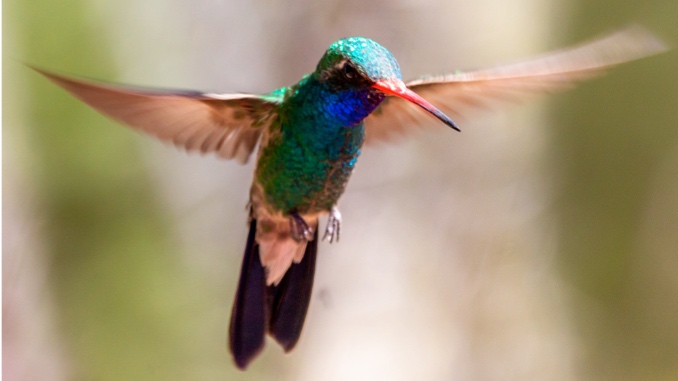
We added the rare Lucifer Hummingbird, a primarily Mexican species with a magnificent magenta throat, at the Ash Canyon Bird Sanctuary before hiking the trails of the Ramsey Canyon Preserve. We were hoping to find see a pair of nesting Pygmy Owls, but the mother stayed in her hole high in a sycamore branch and the father could only be heard in the distance. Nevertheless, we enjoyed our beautiful hike in the preserve, which is protected by The Nature Conservancy, and saw 26 other bird species there.
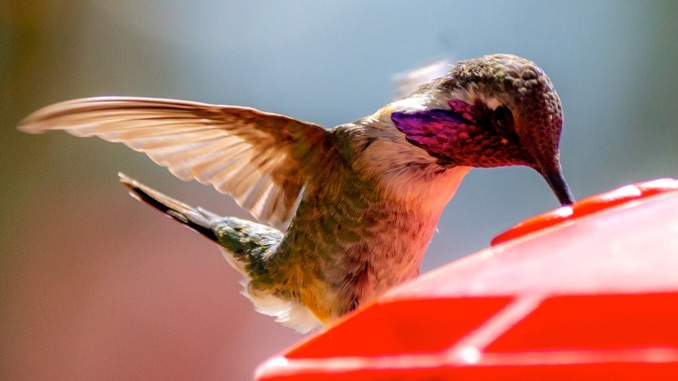
Patagonia’s Charms
We left our guide behind and headed to Patagonia and the Paton Center for Hummingbirds, adding another rare hummer to our list—the Violet-crowned Hummingbird with its distinctive purple cap. But this little preserve run by the Tucson Audubon Society is just as distinctive for its doves with six different species regularly visiting, including my lifer Ruddy Ground Dove. I was most excited to see my first Phainopepla, though. This punk-looking bird is all black with red eyes until it takes flight and a bright splash of white appears across its wings. It’s a common bird for the locals, who were more excited by the rare appearance of a female American Redstart, a bird I get in my backyard back in Georgia.
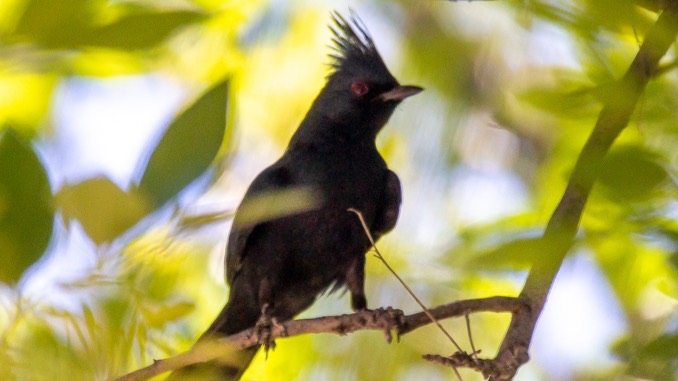
We got coffee at Gathering Grounds in quirky little downtown Patagonia (population 874), worth a stop if you’re nearby, before seeking out our last wayward Central American bird, a female Rose-throated Becard reportedly building a nest near a roadside rest area. We heard her distinct squeaky, stuttering calls before we spotted her in the tall scrub before she settled high up in a sycamore. The female lacks the crimson collar that gives the species its name but the chunky bird with an oversized head still looks unlike anything else in America.
Saguero National Park
Back in Tucson and headed out early the next morning to hike the Douglas Spring Trail, just east of town in Saguero National Park. The giant cartoon-like Saquero Cactuses towered over the landscape, providing habitat for Gila Woodpeckers and Cactus Wrens. We were startled (okay, terrified) by the warning rattle of a Western Diamond-backed Rattlesnake a couple feet from the path. We also saw a long, black Coachwhip snake and countless lizards, along with a myriad of different cactus plants and one new bird species for me, the Rufous-Winged Sparrow, whose mostly Mexican range only extends just a sliver into southern Arizona. But for the second time on the trip, the scenery of the Sonoran Desert outshone the birds we saw.

With our afternoon flights approaching, we made time for one last stop on the way to the airport. Lakeside Park is a rare body of water in Tucson and the unexpected home to a Forster’s Tern that had become a mini-celebrity among local birders. Almost as unusual was my final lifer of the trip, a lone Snow Goose. That gave me 79 new birds for the trip out of the 170 species we were able to identify. That will be hard to replicate anywhere else in America.







































